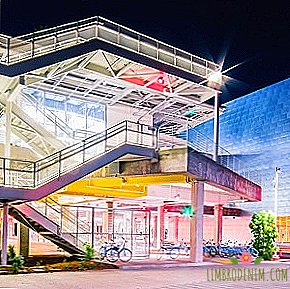How I built a school in Nepal after the earthquake
I studied and trained in Europe. When the residence permit in the European Union ended, she went to travel to Latin America - she visited Peru, Bolivia, Brazil. In the last six months, I worked as a business English teacher, and also volunteered at a non-governmental organization that made free lessons for children in English, drawing and programming, as well as counseling for women in difficult situations.
I volunteered, firstly, because my magistracy was associated with humanitarian projects, and secondly, because I wanted to communicate more with the locals. I had to return to Russia in six months, because the Russians can stay in Brazil without a visa for just such a period.

Soon, I became pleased to participate in various types of construction. Most of all I liked to paint - a very meditative practice, and most importantly, you can immediately see the result of your labors.
Then I decided to find a project in the humanitarian sphere, where I could participate without special experience and an entrance fee (many organizations require it). After a long search, I stopped at the organization All Hands Volunteers, they had some interesting programs in the US, Ecuador and Nepal. I thought that Ecuador was too expensive and too long to fly, but Nepal is close enough to Russia. In addition, it was necessary to pay only for air tickets, the rest was provided by All Hands Volunteers.
I arrived in Nepal in December when construction was in the final stage. Already there were two buildings, each of which had four classrooms. The foundation, roof and walls were erected. But there was still much to do: it was necessary to sift the sand, knead the concrete, level the floors, paint the walls and install the windows. The school was opened by the end of January, and the guys who wanted to stay in Nepal a little longer were transferred to the construction of other facilities. The project was associated with the elimination of damage due to the earthquake in 2015, so that the work in the country was still full.
You can fly to Nepal fairly cheaply - tickets to Kathmandu (the capital of Nepal) can cost you twenty thousand rubles. I flew there from St. Petersburg via Istanbul, and back through New Delhi to Moscow. It was fundamentally important to take more warm clothes with us, since we lived and worked in the foothill region, located at an altitude of eight hundred meters above sea level. Thus, if in the afternoon the temperature was about +20 degrees, then in the evening it sharply dropped to +5. We were also warned in advance that in Nepal it is considered indecent to open shoulders, so instead of T-shirts we wore T-shirts. Otherwise, there was no inconvenience - I am quite a healthy person. Moreover, before that I visited India, where living conditions seemed to me less comfortable.

Upon arrival, we were placed in a hotel, which the organization rented for the whole time the school was built - a three-story building with a small area around it. We lived in large rooms like those in hostels - men and women were accommodated together. But when submitting the application, it was possible to separately indicate that you cannot live with men for some personal reasons. Suppose my Muslim friend from Malaysia lived in a room where there were only girls.
We worked six days a week, like all Nepalese, from eight in the morning until four in the afternoon with two breaks for tea and lunch. But at 7:30 it was necessary to get on the bus, since we lived half an hour from the school. We came back to the hostel at half past five, at which time every time a general meeting was held, where we discussed the results of the day and plans for the future, and also got acquainted with the newcomers. Lunch was held in a cafe near the construction site, where you could choose different dishes - this was paid by the organization. Breakfast was prepared by themselves from the products that were in the kitchen at the hotel: tea, coffee, eggs, cereals, cereals and stuff like that. Local cooks came to dinner and cooked especially for us.
Each part of the work was managed by a volunteer who had been involved in construction for a long time and was well versed in, say, mixing concrete. Every morning there was a planning meeting, where you could choose which team you would join today - whether to install scaffolding or paint the walls.

The first few days I didn’t understand how the work at the construction site was arranged, so I immediately took to sift the sand, thinking that this would be the easiest thing. It turned out that after eight hours of such work, my back starts to ache terribly. But soon even this discomfort was gone, and I became happy to participate in various affairs. Most of all I liked to paint - a very meditative practice, and most importantly, you can immediately see the result of their labors.
We tried to come to each other to help and change the types of work. For example, if someone was physically tired, but wanted to continue to do something less energy-consuming. But in general, to have an athletic form was not at all necessary - both eighteen and seventy five years were successfully engaged in building. For example, there was a grandfather from the USA who went to volunteer in Nepal half a century ago. He came to see his friends from those times and again participate in a project useful for the country. He was very inspired: he worked on a par with young people and did not shirk.
For people who came to volunteer for a long time, the schedule was made in such a way that for each month of work relied an additional three days of rest - at this time it was possible to go to another region of Nepal. Half an hour away from our school by bus were the square and the temple complex of Nouvacoth Durbar, belonging to the cultural heritage of UNESCO. It was the closest attraction - you had to get a little longer.

In Nepal, most people still order clothes from tailors, and local fabrics, carvings and objects for religious ceremonies are simply amazing.
I decided to go to the Hindu temple of Manakaman - not the most tourist place, but a very popular point for local pilgrims. Manakamana is located one hundred and fifty kilometers from Kathmandu, and before that the locals had crossed this path on foot. Unfortunately, the temple was destroyed during the 2015 earthquake. But the holy place remains so, no matter what, so that the flow of pilgrims does not stop, and of course, work is under way to restore it.
Then I wanted to go through a mountain track - a popular pastime for Nepal. She stopped at Mardi Himal, whose route passes through the lower Annapurna region. (mountain range in the Himalayas - Approx. Ed.) to the top of mardi. This option seemed to me the most convenient, because, rising to a height of less than four thousand meters, you can not take a guide. In addition, I decided that getting higher could be hard physically, although the work at the construction site made me much stronger and more enduring. I crossed the weekly route quite easily, even if it was not a full-fledged mountain climb.
Before my trip to Nepal, I visited 53 countries, so I had something to compare with. I fell in love with this country at first sight - with its colossal untouched nature, kind and surprisingly peace-loving people. For all two months in Nepal, I have not had a chance to see a single conflict situation. I am very impressed that the local people can do everything with their own hands. In Nepal, most people still order clothes from tailors, and fabrics, carvings and objects for religious ceremonies are simply amazing.

The project participants worked with great enthusiasm - I was surprised by the geographical spread. I expected to see western young people who decided to diversify their journey to Nepal with volunteering, but most people flew specially from all over the world - Europe, Canada, USA, Australia, New Zealand, Brazil, Chile, Argentina, Colombia, Peru, Panama, Philippines, Indonesia, China and Vietnam. From Russia, to my regret, only one boy has participated in all the time, moreover, he has been living in Dubai for ten years. Volunteers from Nepal also arrived - they were about 10%, but for such programs it is a very good result.
I happened to meet very interesting and inspiring people. Suppose my friend from Malaysia is an architect. Before coming to Nepal, she worked at an architectural bureau, but she didn’t like it too much: she didn’t feel a connection with people for whom she had designed houses. For the construction of a school in Nepal, she quit her job and became a regular volunteer. According to her, this project made her happier than when she worked in the office. I think it was much easier for all of us to wake up in a cold room and go to work, because we knew that we were building a building for real people.
Also in our team was a ship mechanic from the UK. He had two vacations a year for two weeks, and each of them he spent volunteering in different countries. It seems to me that seeing people who give their personal time and energy to such projects is priceless. I even decided that if everything went wrong in my life and I would be disappointed in people, I would certainly repeat this experience in order to again believe in humanity and in myself.
Photo: personal archive





